Report: Analysis of HR Contractual Models in Tesco and Asda
VerifiedAdded on 2023/01/05
|12
|4187
|25
Report
AI Summary
This report provides a comprehensive analysis of four key human resource contractual models: permanent full-time, permanent part-time, zero-hour, and fixed-term temporary contracts. It delves into the advantages and disadvantages of each model, highlighting their implications for both employers and employees. The report emphasizes the importance of adhering to employment and contract laws to foster positive employee relations and achieve organizational goals. Furthermore, it includes practical examples of how these contractual approaches are implemented in two major retail companies, Tesco and Asda, offering insights into their workforce management strategies. The report underscores the significance of these models in the modern workplace, where employees are increasingly aware of their rights and seek employers who respect them. The report concludes by highlighting the benefits of adopting appropriate contractual models for maintaining a productive and engaged workforce.
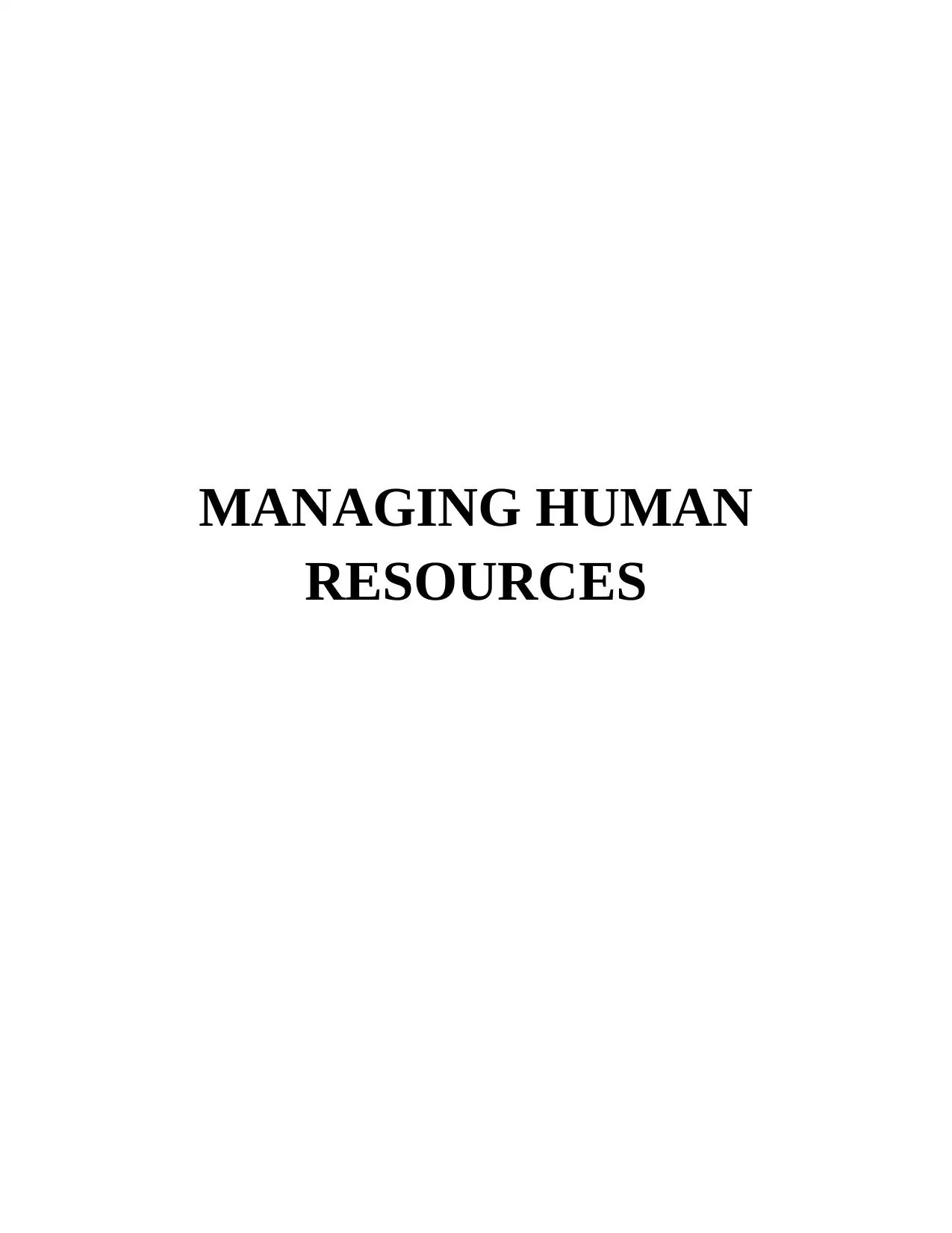
MANAGING HUMAN
RESOURCES
RESOURCES
Paraphrase This Document
Need a fresh take? Get an instant paraphrase of this document with our AI Paraphraser
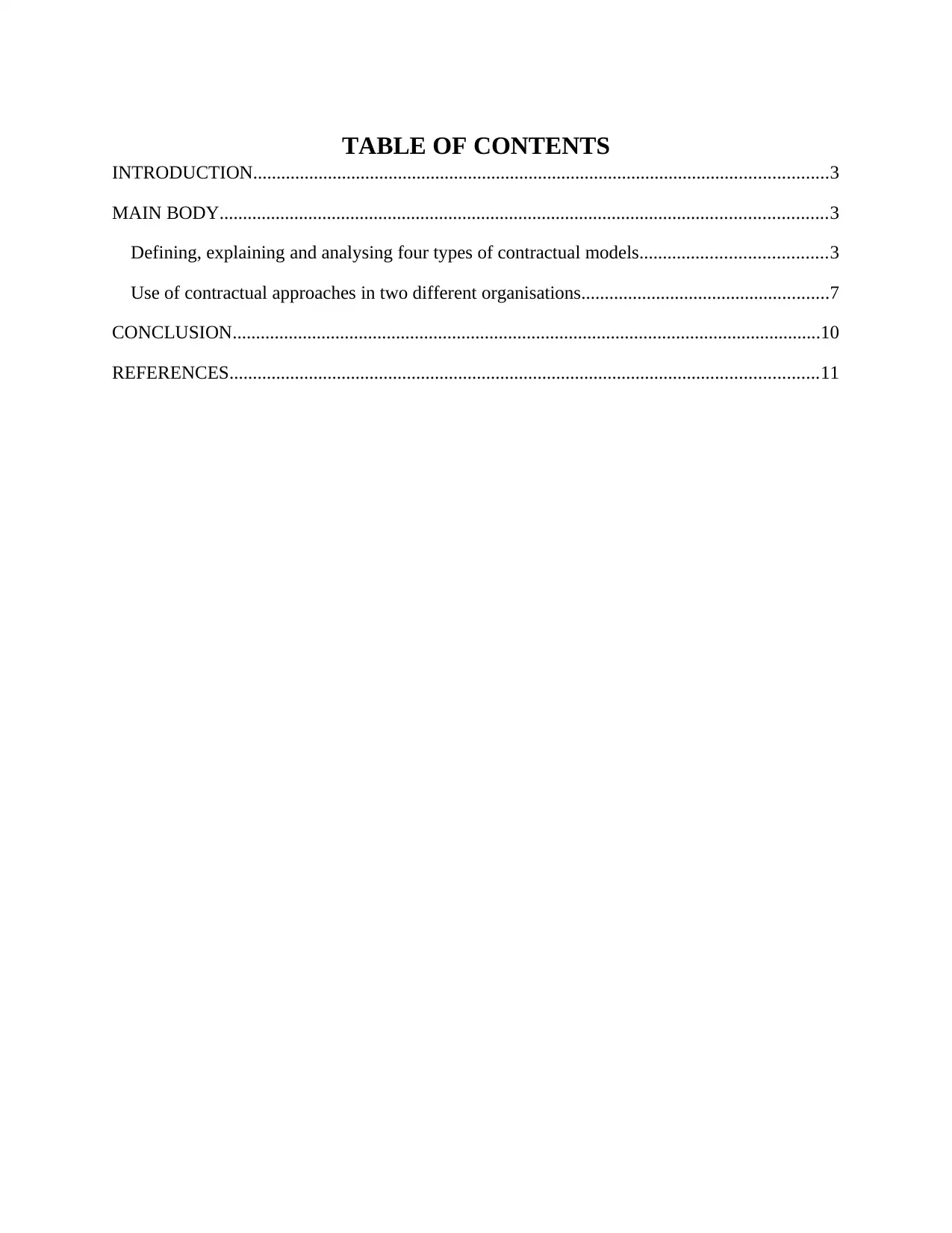
TABLE OF CONTENTS
INTRODUCTION...........................................................................................................................3
MAIN BODY..................................................................................................................................3
Defining, explaining and analysing four types of contractual models........................................3
Use of contractual approaches in two different organisations.....................................................7
CONCLUSION..............................................................................................................................10
REFERENCES..............................................................................................................................11
INTRODUCTION...........................................................................................................................3
MAIN BODY..................................................................................................................................3
Defining, explaining and analysing four types of contractual models........................................3
Use of contractual approaches in two different organisations.....................................................7
CONCLUSION..............................................................................................................................10
REFERENCES..............................................................................................................................11
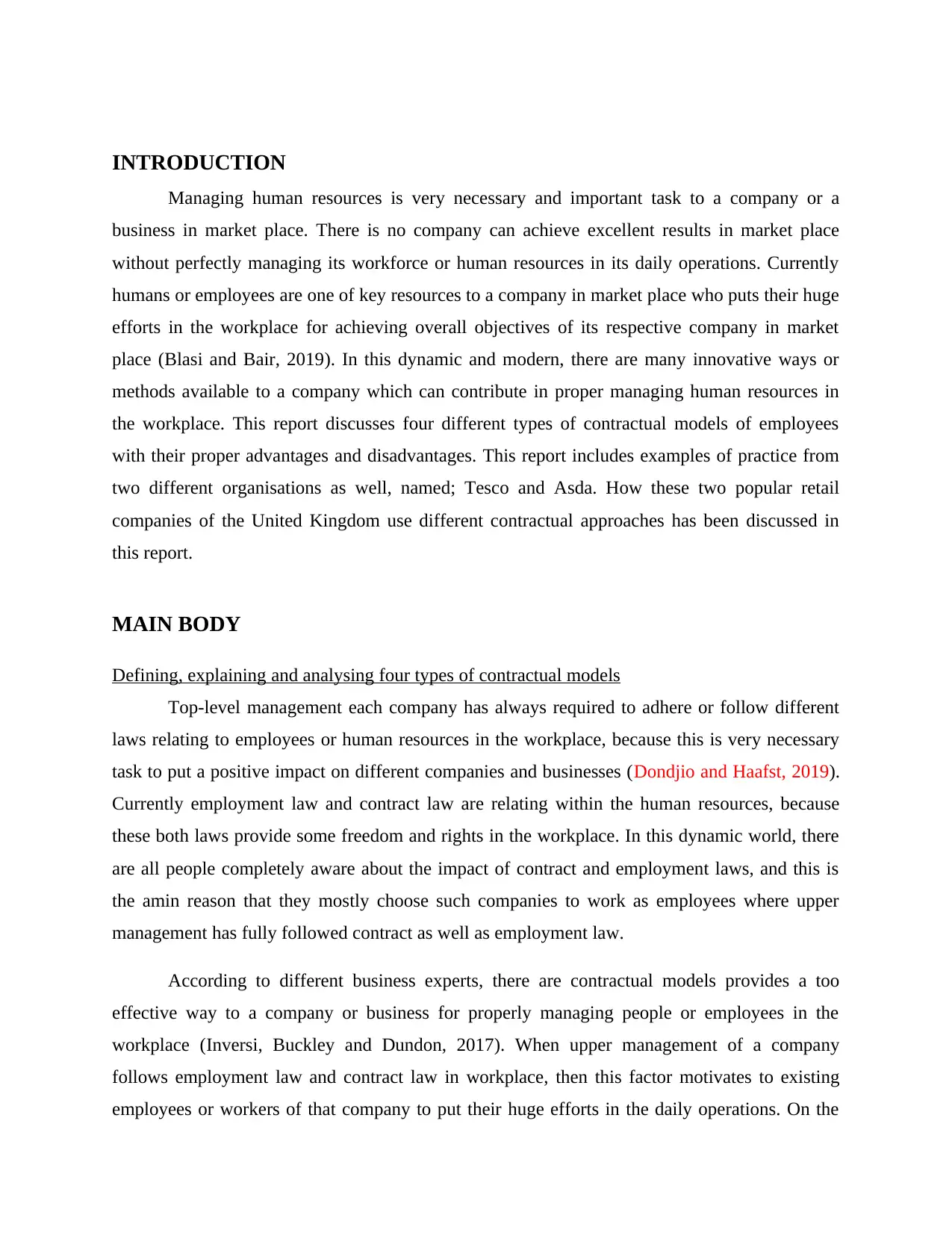
INTRODUCTION
Managing human resources is very necessary and important task to a company or a
business in market place. There is no company can achieve excellent results in market place
without perfectly managing its workforce or human resources in its daily operations. Currently
humans or employees are one of key resources to a company in market place who puts their huge
efforts in the workplace for achieving overall objectives of its respective company in market
place (Blasi and Bair, 2019). In this dynamic and modern, there are many innovative ways or
methods available to a company which can contribute in proper managing human resources in
the workplace. This report discusses four different types of contractual models of employees
with their proper advantages and disadvantages. This report includes examples of practice from
two different organisations as well, named; Tesco and Asda. How these two popular retail
companies of the United Kingdom use different contractual approaches has been discussed in
this report.
MAIN BODY
Defining, explaining and analysing four types of contractual models
Top-level management each company has always required to adhere or follow different
laws relating to employees or human resources in the workplace, because this is very necessary
task to put a positive impact on different companies and businesses (Dondjio and Haafst, 2019).
Currently employment law and contract law are relating within the human resources, because
these both laws provide some freedom and rights in the workplace. In this dynamic world, there
are all people completely aware about the impact of contract and employment laws, and this is
the amin reason that they mostly choose such companies to work as employees where upper
management has fully followed contract as well as employment law.
According to different business experts, there are contractual models provides a too
effective way to a company or business for properly managing people or employees in the
workplace (Inversi, Buckley and Dundon, 2017). When upper management of a company
follows employment law and contract law in workplace, then this factor motivates to existing
employees or workers of that company to put their huge efforts in the daily operations. On the
Managing human resources is very necessary and important task to a company or a
business in market place. There is no company can achieve excellent results in market place
without perfectly managing its workforce or human resources in its daily operations. Currently
humans or employees are one of key resources to a company in market place who puts their huge
efforts in the workplace for achieving overall objectives of its respective company in market
place (Blasi and Bair, 2019). In this dynamic and modern, there are many innovative ways or
methods available to a company which can contribute in proper managing human resources in
the workplace. This report discusses four different types of contractual models of employees
with their proper advantages and disadvantages. This report includes examples of practice from
two different organisations as well, named; Tesco and Asda. How these two popular retail
companies of the United Kingdom use different contractual approaches has been discussed in
this report.
MAIN BODY
Defining, explaining and analysing four types of contractual models
Top-level management each company has always required to adhere or follow different
laws relating to employees or human resources in the workplace, because this is very necessary
task to put a positive impact on different companies and businesses (Dondjio and Haafst, 2019).
Currently employment law and contract law are relating within the human resources, because
these both laws provide some freedom and rights in the workplace. In this dynamic world, there
are all people completely aware about the impact of contract and employment laws, and this is
the amin reason that they mostly choose such companies to work as employees where upper
management has fully followed contract as well as employment law.
According to different business experts, there are contractual models provides a too
effective way to a company or business for properly managing people or employees in the
workplace (Inversi, Buckley and Dundon, 2017). When upper management of a company
follows employment law and contract law in workplace, then this factor motivates to existing
employees or workers of that company to put their huge efforts in the daily operations. On the
⊘ This is a preview!⊘
Do you want full access?
Subscribe today to unlock all pages.

Trusted by 1+ million students worldwide
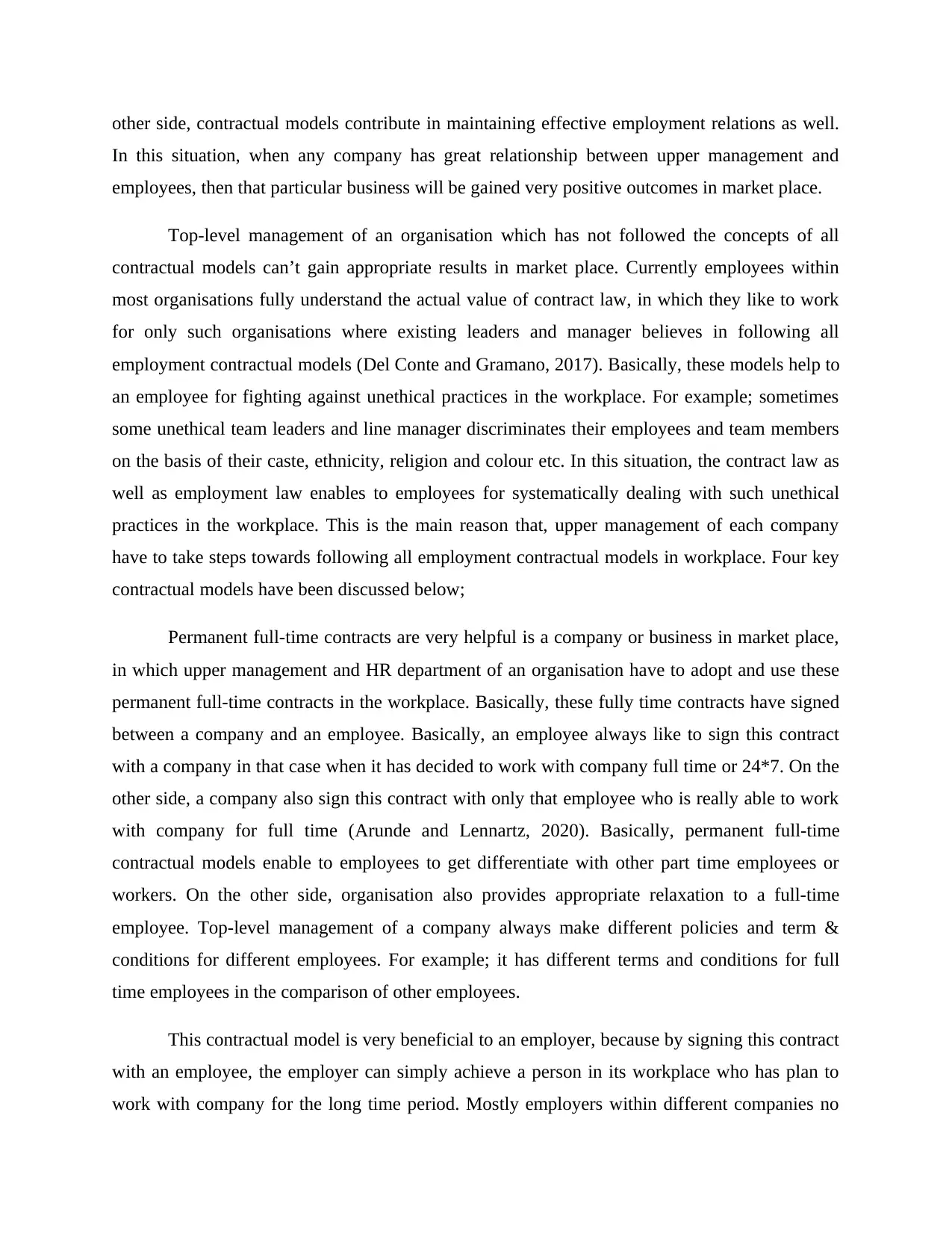
other side, contractual models contribute in maintaining effective employment relations as well.
In this situation, when any company has great relationship between upper management and
employees, then that particular business will be gained very positive outcomes in market place.
Top-level management of an organisation which has not followed the concepts of all
contractual models can’t gain appropriate results in market place. Currently employees within
most organisations fully understand the actual value of contract law, in which they like to work
for only such organisations where existing leaders and manager believes in following all
employment contractual models (Del Conte and Gramano, 2017). Basically, these models help to
an employee for fighting against unethical practices in the workplace. For example; sometimes
some unethical team leaders and line manager discriminates their employees and team members
on the basis of their caste, ethnicity, religion and colour etc. In this situation, the contract law as
well as employment law enables to employees for systematically dealing with such unethical
practices in the workplace. This is the main reason that, upper management of each company
have to take steps towards following all employment contractual models in workplace. Four key
contractual models have been discussed below;
Permanent full-time contracts are very helpful is a company or business in market place,
in which upper management and HR department of an organisation have to adopt and use these
permanent full-time contracts in the workplace. Basically, these fully time contracts have signed
between a company and an employee. Basically, an employee always like to sign this contract
with a company in that case when it has decided to work with company full time or 24*7. On the
other side, a company also sign this contract with only that employee who is really able to work
with company for full time (Arunde and Lennartz, 2020). Basically, permanent full-time
contractual models enable to employees to get differentiate with other part time employees or
workers. On the other side, organisation also provides appropriate relaxation to a full-time
employee. Top-level management of a company always make different policies and term &
conditions for different employees. For example; it has different terms and conditions for full
time employees in the comparison of other employees.
This contractual model is very beneficial to an employer, because by signing this contract
with an employee, the employer can simply achieve a person in its workplace who has plan to
work with company for the long time period. Mostly employers within different companies no
In this situation, when any company has great relationship between upper management and
employees, then that particular business will be gained very positive outcomes in market place.
Top-level management of an organisation which has not followed the concepts of all
contractual models can’t gain appropriate results in market place. Currently employees within
most organisations fully understand the actual value of contract law, in which they like to work
for only such organisations where existing leaders and manager believes in following all
employment contractual models (Del Conte and Gramano, 2017). Basically, these models help to
an employee for fighting against unethical practices in the workplace. For example; sometimes
some unethical team leaders and line manager discriminates their employees and team members
on the basis of their caste, ethnicity, religion and colour etc. In this situation, the contract law as
well as employment law enables to employees for systematically dealing with such unethical
practices in the workplace. This is the main reason that, upper management of each company
have to take steps towards following all employment contractual models in workplace. Four key
contractual models have been discussed below;
Permanent full-time contracts are very helpful is a company or business in market place,
in which upper management and HR department of an organisation have to adopt and use these
permanent full-time contracts in the workplace. Basically, these fully time contracts have signed
between a company and an employee. Basically, an employee always like to sign this contract
with a company in that case when it has decided to work with company full time or 24*7. On the
other side, a company also sign this contract with only that employee who is really able to work
with company for full time (Arunde and Lennartz, 2020). Basically, permanent full-time
contractual models enable to employees to get differentiate with other part time employees or
workers. On the other side, organisation also provides appropriate relaxation to a full-time
employee. Top-level management of a company always make different policies and term &
conditions for different employees. For example; it has different terms and conditions for full
time employees in the comparison of other employees.
This contractual model is very beneficial to an employer, because by signing this contract
with an employee, the employer can simply achieve a person in its workplace who has plan to
work with company for the long time period. Mostly employers within different companies no
Paraphrase This Document
Need a fresh take? Get an instant paraphrase of this document with our AI Paraphraser
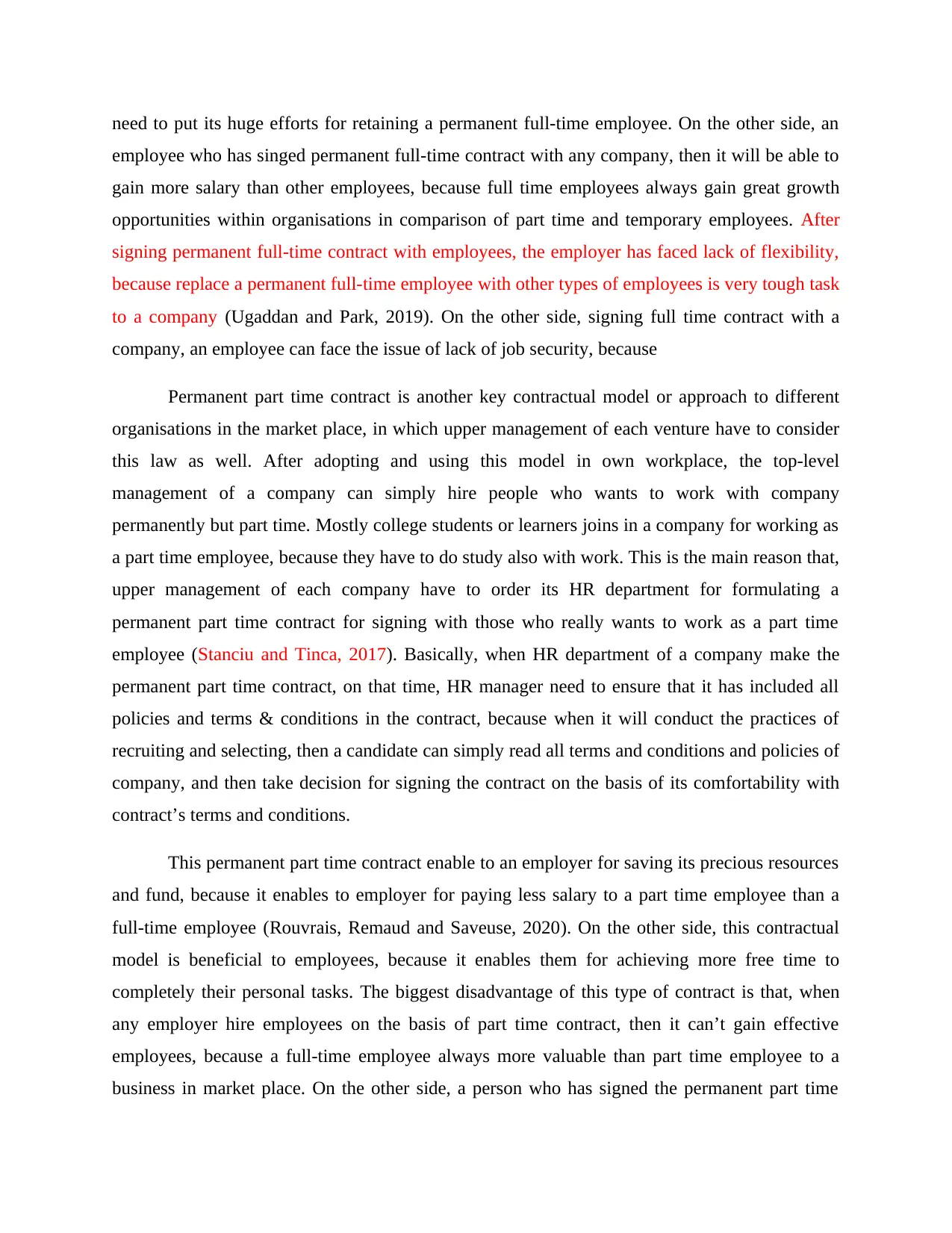
need to put its huge efforts for retaining a permanent full-time employee. On the other side, an
employee who has singed permanent full-time contract with any company, then it will be able to
gain more salary than other employees, because full time employees always gain great growth
opportunities within organisations in comparison of part time and temporary employees. After
signing permanent full-time contract with employees, the employer has faced lack of flexibility,
because replace a permanent full-time employee with other types of employees is very tough task
to a company (Ugaddan and Park, 2019). On the other side, signing full time contract with a
company, an employee can face the issue of lack of job security, because
Permanent part time contract is another key contractual model or approach to different
organisations in the market place, in which upper management of each venture have to consider
this law as well. After adopting and using this model in own workplace, the top-level
management of a company can simply hire people who wants to work with company
permanently but part time. Mostly college students or learners joins in a company for working as
a part time employee, because they have to do study also with work. This is the main reason that,
upper management of each company have to order its HR department for formulating a
permanent part time contract for signing with those who really wants to work as a part time
employee (Stanciu and Tinca, 2017). Basically, when HR department of a company make the
permanent part time contract, on that time, HR manager need to ensure that it has included all
policies and terms & conditions in the contract, because when it will conduct the practices of
recruiting and selecting, then a candidate can simply read all terms and conditions and policies of
company, and then take decision for signing the contract on the basis of its comfortability with
contract’s terms and conditions.
This permanent part time contract enable to an employer for saving its precious resources
and fund, because it enables to employer for paying less salary to a part time employee than a
full-time employee (Rouvrais, Remaud and Saveuse, 2020). On the other side, this contractual
model is beneficial to employees, because it enables them for achieving more free time to
completely their personal tasks. The biggest disadvantage of this type of contract is that, when
any employer hire employees on the basis of part time contract, then it can’t gain effective
employees, because a full-time employee always more valuable than part time employee to a
business in market place. On the other side, a person who has signed the permanent part time
employee who has singed permanent full-time contract with any company, then it will be able to
gain more salary than other employees, because full time employees always gain great growth
opportunities within organisations in comparison of part time and temporary employees. After
signing permanent full-time contract with employees, the employer has faced lack of flexibility,
because replace a permanent full-time employee with other types of employees is very tough task
to a company (Ugaddan and Park, 2019). On the other side, signing full time contract with a
company, an employee can face the issue of lack of job security, because
Permanent part time contract is another key contractual model or approach to different
organisations in the market place, in which upper management of each venture have to consider
this law as well. After adopting and using this model in own workplace, the top-level
management of a company can simply hire people who wants to work with company
permanently but part time. Mostly college students or learners joins in a company for working as
a part time employee, because they have to do study also with work. This is the main reason that,
upper management of each company have to order its HR department for formulating a
permanent part time contract for signing with those who really wants to work as a part time
employee (Stanciu and Tinca, 2017). Basically, when HR department of a company make the
permanent part time contract, on that time, HR manager need to ensure that it has included all
policies and terms & conditions in the contract, because when it will conduct the practices of
recruiting and selecting, then a candidate can simply read all terms and conditions and policies of
company, and then take decision for signing the contract on the basis of its comfortability with
contract’s terms and conditions.
This permanent part time contract enable to an employer for saving its precious resources
and fund, because it enables to employer for paying less salary to a part time employee than a
full-time employee (Rouvrais, Remaud and Saveuse, 2020). On the other side, this contractual
model is beneficial to employees, because it enables them for achieving more free time to
completely their personal tasks. The biggest disadvantage of this type of contract is that, when
any employer hire employees on the basis of part time contract, then it can’t gain effective
employees, because a full-time employee always more valuable than part time employee to a
business in market place. On the other side, a person who has signed the permanent part time
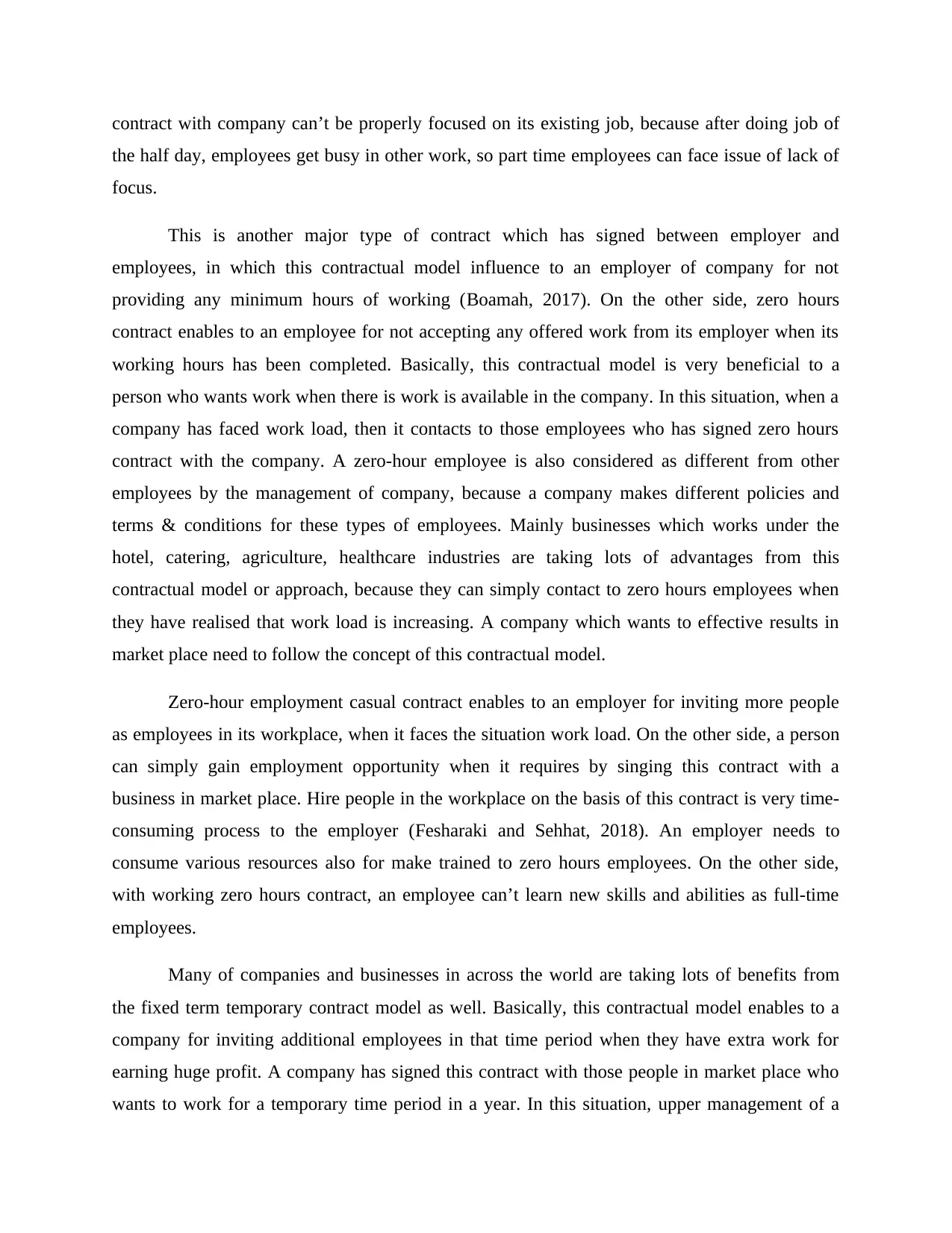
contract with company can’t be properly focused on its existing job, because after doing job of
the half day, employees get busy in other work, so part time employees can face issue of lack of
focus.
This is another major type of contract which has signed between employer and
employees, in which this contractual model influence to an employer of company for not
providing any minimum hours of working (Boamah, 2017). On the other side, zero hours
contract enables to an employee for not accepting any offered work from its employer when its
working hours has been completed. Basically, this contractual model is very beneficial to a
person who wants work when there is work is available in the company. In this situation, when a
company has faced work load, then it contacts to those employees who has signed zero hours
contract with the company. A zero-hour employee is also considered as different from other
employees by the management of company, because a company makes different policies and
terms & conditions for these types of employees. Mainly businesses which works under the
hotel, catering, agriculture, healthcare industries are taking lots of advantages from this
contractual model or approach, because they can simply contact to zero hours employees when
they have realised that work load is increasing. A company which wants to effective results in
market place need to follow the concept of this contractual model.
Zero-hour employment casual contract enables to an employer for inviting more people
as employees in its workplace, when it faces the situation work load. On the other side, a person
can simply gain employment opportunity when it requires by singing this contract with a
business in market place. Hire people in the workplace on the basis of this contract is very time-
consuming process to the employer (Fesharaki and Sehhat, 2018). An employer needs to
consume various resources also for make trained to zero hours employees. On the other side,
with working zero hours contract, an employee can’t learn new skills and abilities as full-time
employees.
Many of companies and businesses in across the world are taking lots of benefits from
the fixed term temporary contract model as well. Basically, this contractual model enables to a
company for inviting additional employees in that time period when they have extra work for
earning huge profit. A company has signed this contract with those people in market place who
wants to work for a temporary time period in a year. In this situation, upper management of a
the half day, employees get busy in other work, so part time employees can face issue of lack of
focus.
This is another major type of contract which has signed between employer and
employees, in which this contractual model influence to an employer of company for not
providing any minimum hours of working (Boamah, 2017). On the other side, zero hours
contract enables to an employee for not accepting any offered work from its employer when its
working hours has been completed. Basically, this contractual model is very beneficial to a
person who wants work when there is work is available in the company. In this situation, when a
company has faced work load, then it contacts to those employees who has signed zero hours
contract with the company. A zero-hour employee is also considered as different from other
employees by the management of company, because a company makes different policies and
terms & conditions for these types of employees. Mainly businesses which works under the
hotel, catering, agriculture, healthcare industries are taking lots of advantages from this
contractual model or approach, because they can simply contact to zero hours employees when
they have realised that work load is increasing. A company which wants to effective results in
market place need to follow the concept of this contractual model.
Zero-hour employment casual contract enables to an employer for inviting more people
as employees in its workplace, when it faces the situation work load. On the other side, a person
can simply gain employment opportunity when it requires by singing this contract with a
business in market place. Hire people in the workplace on the basis of this contract is very time-
consuming process to the employer (Fesharaki and Sehhat, 2018). An employer needs to
consume various resources also for make trained to zero hours employees. On the other side,
with working zero hours contract, an employee can’t learn new skills and abilities as full-time
employees.
Many of companies and businesses in across the world are taking lots of benefits from
the fixed term temporary contract model as well. Basically, this contractual model enables to a
company for inviting additional employees in that time period when they have extra work for
earning huge profit. A company has signed this contract with those people in market place who
wants to work for a temporary time period in a year. In this situation, upper management of a
⊘ This is a preview!⊘
Do you want full access?
Subscribe today to unlock all pages.

Trusted by 1+ million students worldwide
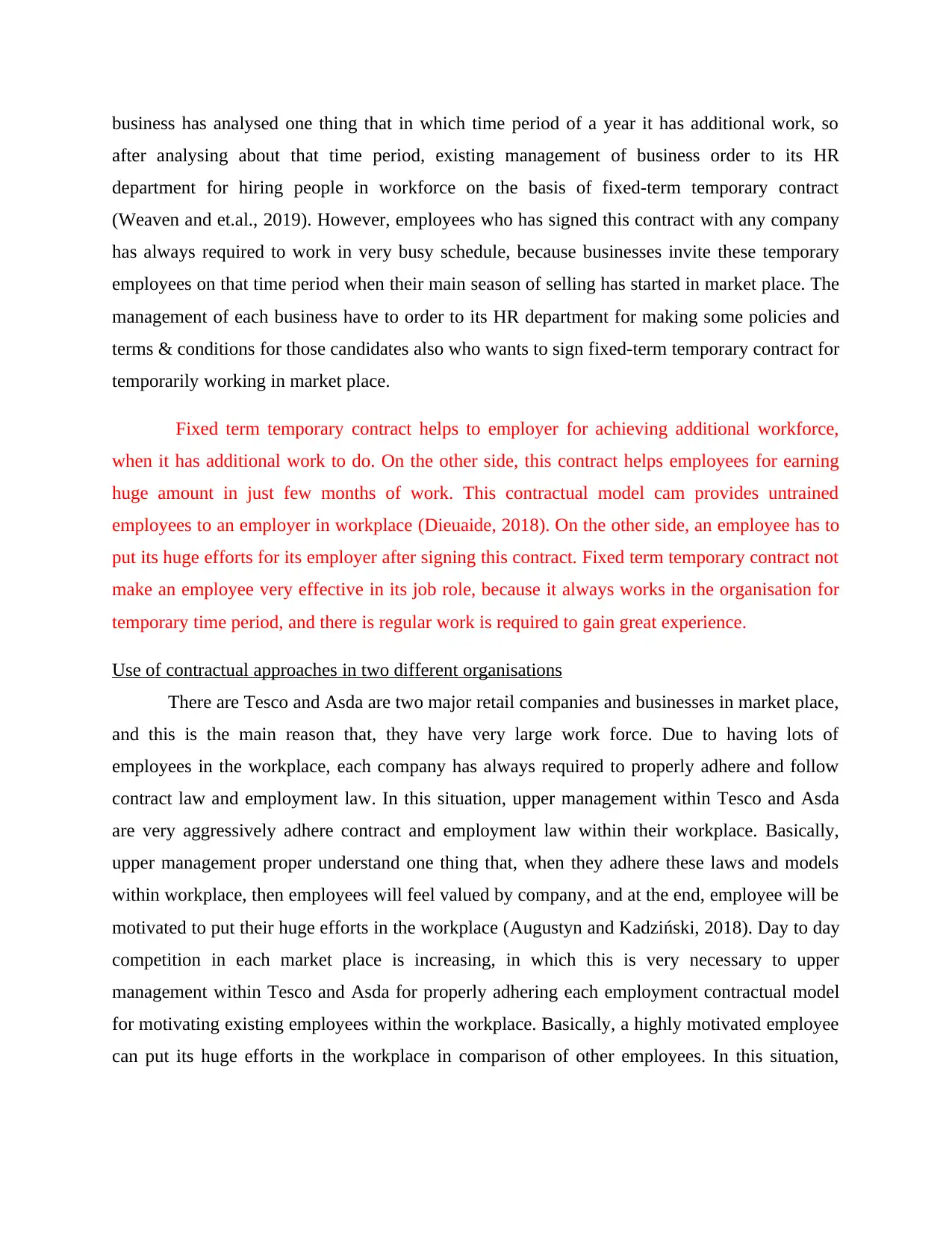
business has analysed one thing that in which time period of a year it has additional work, so
after analysing about that time period, existing management of business order to its HR
department for hiring people in workforce on the basis of fixed-term temporary contract
(Weaven and et.al., 2019). However, employees who has signed this contract with any company
has always required to work in very busy schedule, because businesses invite these temporary
employees on that time period when their main season of selling has started in market place. The
management of each business have to order to its HR department for making some policies and
terms & conditions for those candidates also who wants to sign fixed-term temporary contract for
temporarily working in market place.
Fixed term temporary contract helps to employer for achieving additional workforce,
when it has additional work to do. On the other side, this contract helps employees for earning
huge amount in just few months of work. This contractual model cam provides untrained
employees to an employer in workplace (Dieuaide, 2018). On the other side, an employee has to
put its huge efforts for its employer after signing this contract. Fixed term temporary contract not
make an employee very effective in its job role, because it always works in the organisation for
temporary time period, and there is regular work is required to gain great experience.
Use of contractual approaches in two different organisations
There are Tesco and Asda are two major retail companies and businesses in market place,
and this is the main reason that, they have very large work force. Due to having lots of
employees in the workplace, each company has always required to properly adhere and follow
contract law and employment law. In this situation, upper management within Tesco and Asda
are very aggressively adhere contract and employment law within their workplace. Basically,
upper management proper understand one thing that, when they adhere these laws and models
within workplace, then employees will feel valued by company, and at the end, employee will be
motivated to put their huge efforts in the workplace (Augustyn and Kadziński, 2018). Day to day
competition in each market place is increasing, in which this is very necessary to upper
management within Tesco and Asda for properly adhering each employment contractual model
for motivating existing employees within the workplace. Basically, a highly motivated employee
can put its huge efforts in the workplace in comparison of other employees. In this situation,
after analysing about that time period, existing management of business order to its HR
department for hiring people in workforce on the basis of fixed-term temporary contract
(Weaven and et.al., 2019). However, employees who has signed this contract with any company
has always required to work in very busy schedule, because businesses invite these temporary
employees on that time period when their main season of selling has started in market place. The
management of each business have to order to its HR department for making some policies and
terms & conditions for those candidates also who wants to sign fixed-term temporary contract for
temporarily working in market place.
Fixed term temporary contract helps to employer for achieving additional workforce,
when it has additional work to do. On the other side, this contract helps employees for earning
huge amount in just few months of work. This contractual model cam provides untrained
employees to an employer in workplace (Dieuaide, 2018). On the other side, an employee has to
put its huge efforts for its employer after signing this contract. Fixed term temporary contract not
make an employee very effective in its job role, because it always works in the organisation for
temporary time period, and there is regular work is required to gain great experience.
Use of contractual approaches in two different organisations
There are Tesco and Asda are two major retail companies and businesses in market place,
and this is the main reason that, they have very large work force. Due to having lots of
employees in the workplace, each company has always required to properly adhere and follow
contract law and employment law. In this situation, upper management within Tesco and Asda
are very aggressively adhere contract and employment law within their workplace. Basically,
upper management proper understand one thing that, when they adhere these laws and models
within workplace, then employees will feel valued by company, and at the end, employee will be
motivated to put their huge efforts in the workplace (Augustyn and Kadziński, 2018). Day to day
competition in each market place is increasing, in which this is very necessary to upper
management within Tesco and Asda for properly adhering each employment contractual model
for motivating existing employees within the workplace. Basically, a highly motivated employee
can put its huge efforts in the workplace in comparison of other employees. In this situation,
Paraphrase This Document
Need a fresh take? Get an instant paraphrase of this document with our AI Paraphraser
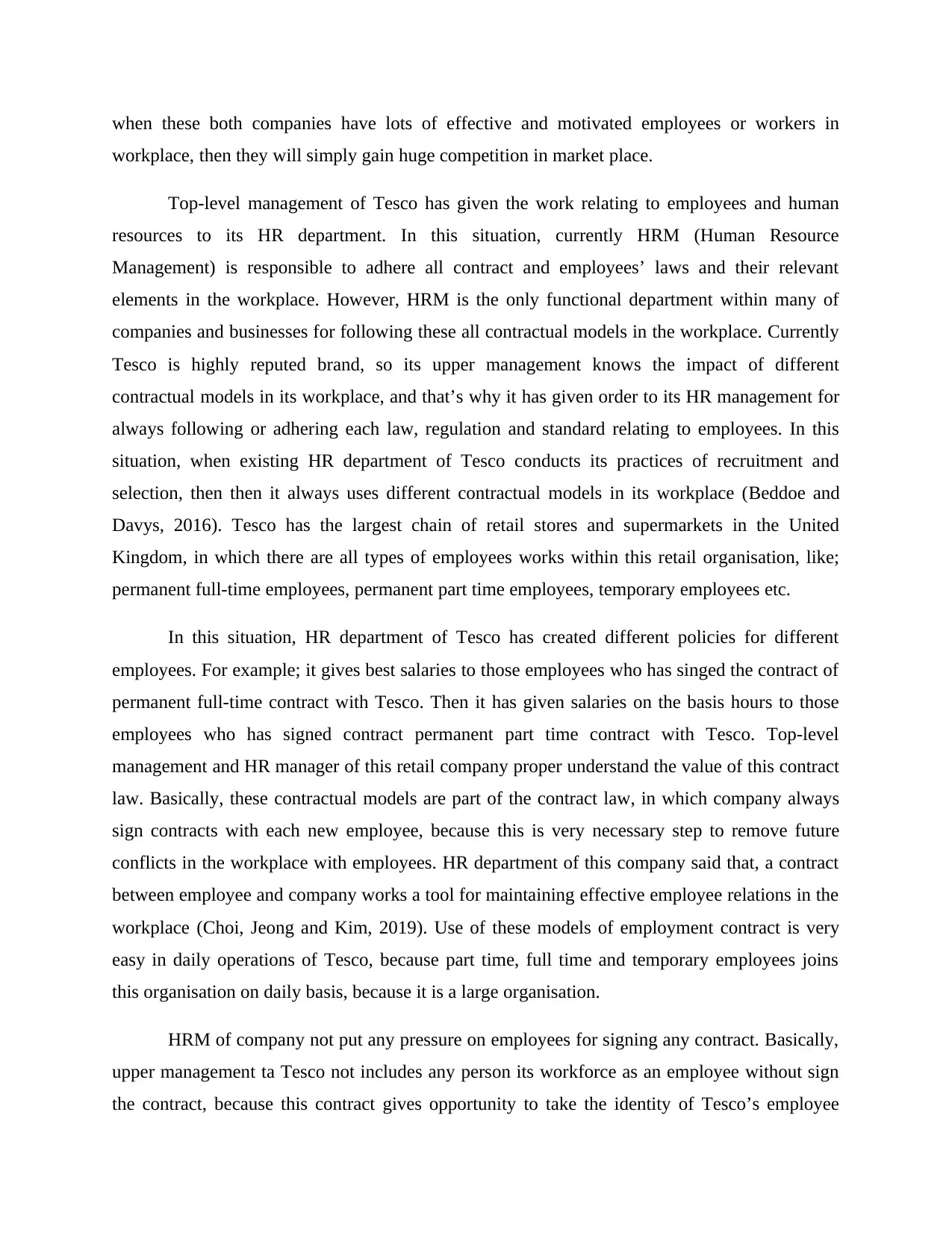
when these both companies have lots of effective and motivated employees or workers in
workplace, then they will simply gain huge competition in market place.
Top-level management of Tesco has given the work relating to employees and human
resources to its HR department. In this situation, currently HRM (Human Resource
Management) is responsible to adhere all contract and employees’ laws and their relevant
elements in the workplace. However, HRM is the only functional department within many of
companies and businesses for following these all contractual models in the workplace. Currently
Tesco is highly reputed brand, so its upper management knows the impact of different
contractual models in its workplace, and that’s why it has given order to its HR management for
always following or adhering each law, regulation and standard relating to employees. In this
situation, when existing HR department of Tesco conducts its practices of recruitment and
selection, then then it always uses different contractual models in its workplace (Beddoe and
Davys, 2016). Tesco has the largest chain of retail stores and supermarkets in the United
Kingdom, in which there are all types of employees works within this retail organisation, like;
permanent full-time employees, permanent part time employees, temporary employees etc.
In this situation, HR department of Tesco has created different policies for different
employees. For example; it gives best salaries to those employees who has singed the contract of
permanent full-time contract with Tesco. Then it has given salaries on the basis hours to those
employees who has signed contract permanent part time contract with Tesco. Top-level
management and HR manager of this retail company proper understand the value of this contract
law. Basically, these contractual models are part of the contract law, in which company always
sign contracts with each new employee, because this is very necessary step to remove future
conflicts in the workplace with employees. HR department of this company said that, a contract
between employee and company works a tool for maintaining effective employee relations in the
workplace (Choi, Jeong and Kim, 2019). Use of these models of employment contract is very
easy in daily operations of Tesco, because part time, full time and temporary employees joins
this organisation on daily basis, because it is a large organisation.
HRM of company not put any pressure on employees for signing any contract. Basically,
upper management ta Tesco not includes any person its workforce as an employee without sign
the contract, because this contract gives opportunity to take the identity of Tesco’s employee
workplace, then they will simply gain huge competition in market place.
Top-level management of Tesco has given the work relating to employees and human
resources to its HR department. In this situation, currently HRM (Human Resource
Management) is responsible to adhere all contract and employees’ laws and their relevant
elements in the workplace. However, HRM is the only functional department within many of
companies and businesses for following these all contractual models in the workplace. Currently
Tesco is highly reputed brand, so its upper management knows the impact of different
contractual models in its workplace, and that’s why it has given order to its HR management for
always following or adhering each law, regulation and standard relating to employees. In this
situation, when existing HR department of Tesco conducts its practices of recruitment and
selection, then then it always uses different contractual models in its workplace (Beddoe and
Davys, 2016). Tesco has the largest chain of retail stores and supermarkets in the United
Kingdom, in which there are all types of employees works within this retail organisation, like;
permanent full-time employees, permanent part time employees, temporary employees etc.
In this situation, HR department of Tesco has created different policies for different
employees. For example; it gives best salaries to those employees who has singed the contract of
permanent full-time contract with Tesco. Then it has given salaries on the basis hours to those
employees who has signed contract permanent part time contract with Tesco. Top-level
management and HR manager of this retail company proper understand the value of this contract
law. Basically, these contractual models are part of the contract law, in which company always
sign contracts with each new employee, because this is very necessary step to remove future
conflicts in the workplace with employees. HR department of this company said that, a contract
between employee and company works a tool for maintaining effective employee relations in the
workplace (Choi, Jeong and Kim, 2019). Use of these models of employment contract is very
easy in daily operations of Tesco, because part time, full time and temporary employees joins
this organisation on daily basis, because it is a large organisation.
HRM of company not put any pressure on employees for signing any contract. Basically,
upper management ta Tesco not includes any person its workforce as an employee without sign
the contract, because this contract gives opportunity to take the identity of Tesco’s employee
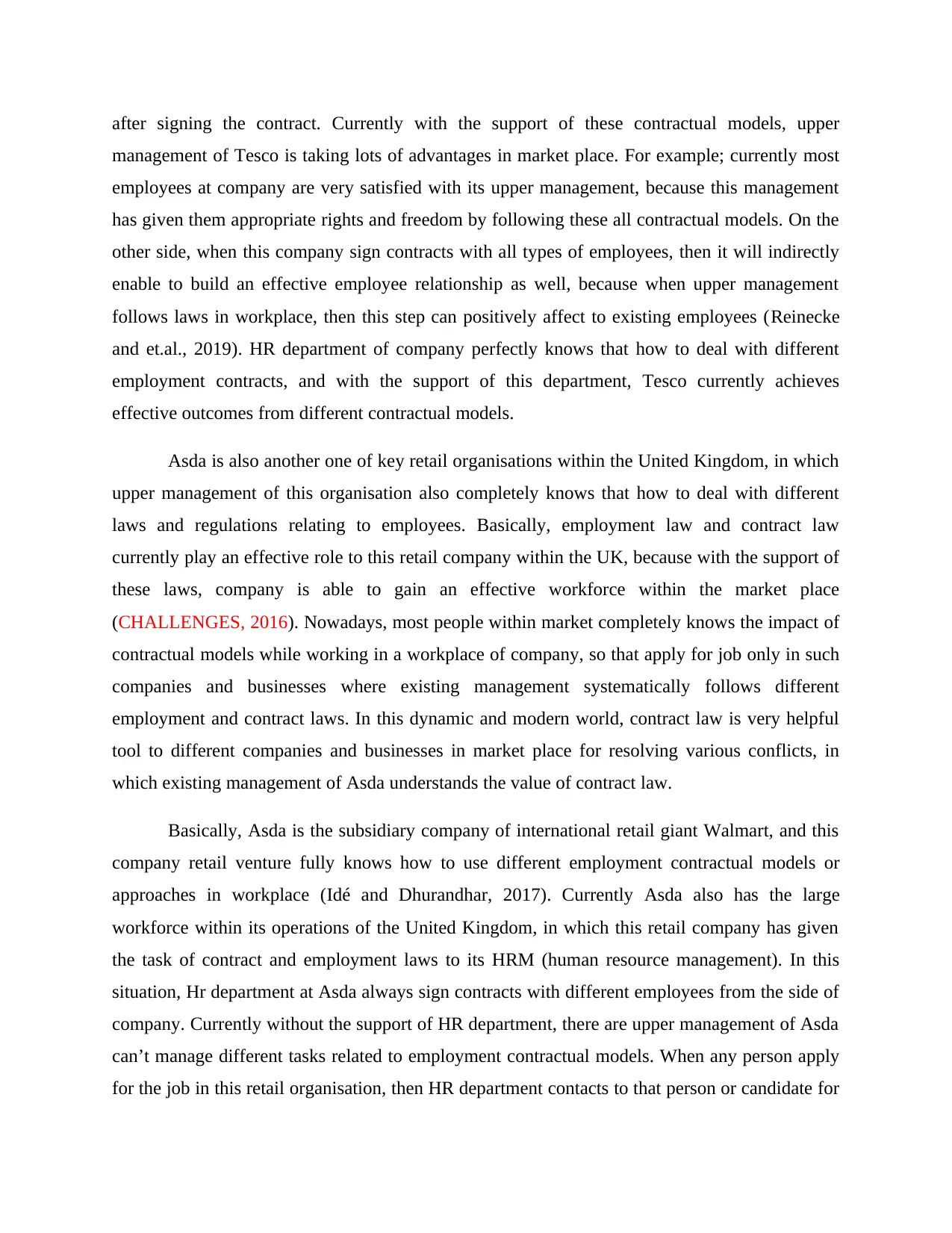
after signing the contract. Currently with the support of these contractual models, upper
management of Tesco is taking lots of advantages in market place. For example; currently most
employees at company are very satisfied with its upper management, because this management
has given them appropriate rights and freedom by following these all contractual models. On the
other side, when this company sign contracts with all types of employees, then it will indirectly
enable to build an effective employee relationship as well, because when upper management
follows laws in workplace, then this step can positively affect to existing employees (Reinecke
and et.al., 2019). HR department of company perfectly knows that how to deal with different
employment contracts, and with the support of this department, Tesco currently achieves
effective outcomes from different contractual models.
Asda is also another one of key retail organisations within the United Kingdom, in which
upper management of this organisation also completely knows that how to deal with different
laws and regulations relating to employees. Basically, employment law and contract law
currently play an effective role to this retail company within the UK, because with the support of
these laws, company is able to gain an effective workforce within the market place
(CHALLENGES, 2016). Nowadays, most people within market completely knows the impact of
contractual models while working in a workplace of company, so that apply for job only in such
companies and businesses where existing management systematically follows different
employment and contract laws. In this dynamic and modern world, contract law is very helpful
tool to different companies and businesses in market place for resolving various conflicts, in
which existing management of Asda understands the value of contract law.
Basically, Asda is the subsidiary company of international retail giant Walmart, and this
company retail venture fully knows how to use different employment contractual models or
approaches in workplace (Idé and Dhurandhar, 2017). Currently Asda also has the large
workforce within its operations of the United Kingdom, in which this retail company has given
the task of contract and employment laws to its HRM (human resource management). In this
situation, Hr department at Asda always sign contracts with different employees from the side of
company. Currently without the support of HR department, there are upper management of Asda
can’t manage different tasks related to employment contractual models. When any person apply
for the job in this retail organisation, then HR department contacts to that person or candidate for
management of Tesco is taking lots of advantages in market place. For example; currently most
employees at company are very satisfied with its upper management, because this management
has given them appropriate rights and freedom by following these all contractual models. On the
other side, when this company sign contracts with all types of employees, then it will indirectly
enable to build an effective employee relationship as well, because when upper management
follows laws in workplace, then this step can positively affect to existing employees (Reinecke
and et.al., 2019). HR department of company perfectly knows that how to deal with different
employment contracts, and with the support of this department, Tesco currently achieves
effective outcomes from different contractual models.
Asda is also another one of key retail organisations within the United Kingdom, in which
upper management of this organisation also completely knows that how to deal with different
laws and regulations relating to employees. Basically, employment law and contract law
currently play an effective role to this retail company within the UK, because with the support of
these laws, company is able to gain an effective workforce within the market place
(CHALLENGES, 2016). Nowadays, most people within market completely knows the impact of
contractual models while working in a workplace of company, so that apply for job only in such
companies and businesses where existing management systematically follows different
employment and contract laws. In this dynamic and modern world, contract law is very helpful
tool to different companies and businesses in market place for resolving various conflicts, in
which existing management of Asda understands the value of contract law.
Basically, Asda is the subsidiary company of international retail giant Walmart, and this
company retail venture fully knows how to use different employment contractual models or
approaches in workplace (Idé and Dhurandhar, 2017). Currently Asda also has the large
workforce within its operations of the United Kingdom, in which this retail company has given
the task of contract and employment laws to its HRM (human resource management). In this
situation, Hr department at Asda always sign contracts with different employees from the side of
company. Currently without the support of HR department, there are upper management of Asda
can’t manage different tasks related to employment contractual models. When any person apply
for the job in this retail organisation, then HR department contacts to that person or candidate for
⊘ This is a preview!⊘
Do you want full access?
Subscribe today to unlock all pages.

Trusted by 1+ million students worldwide
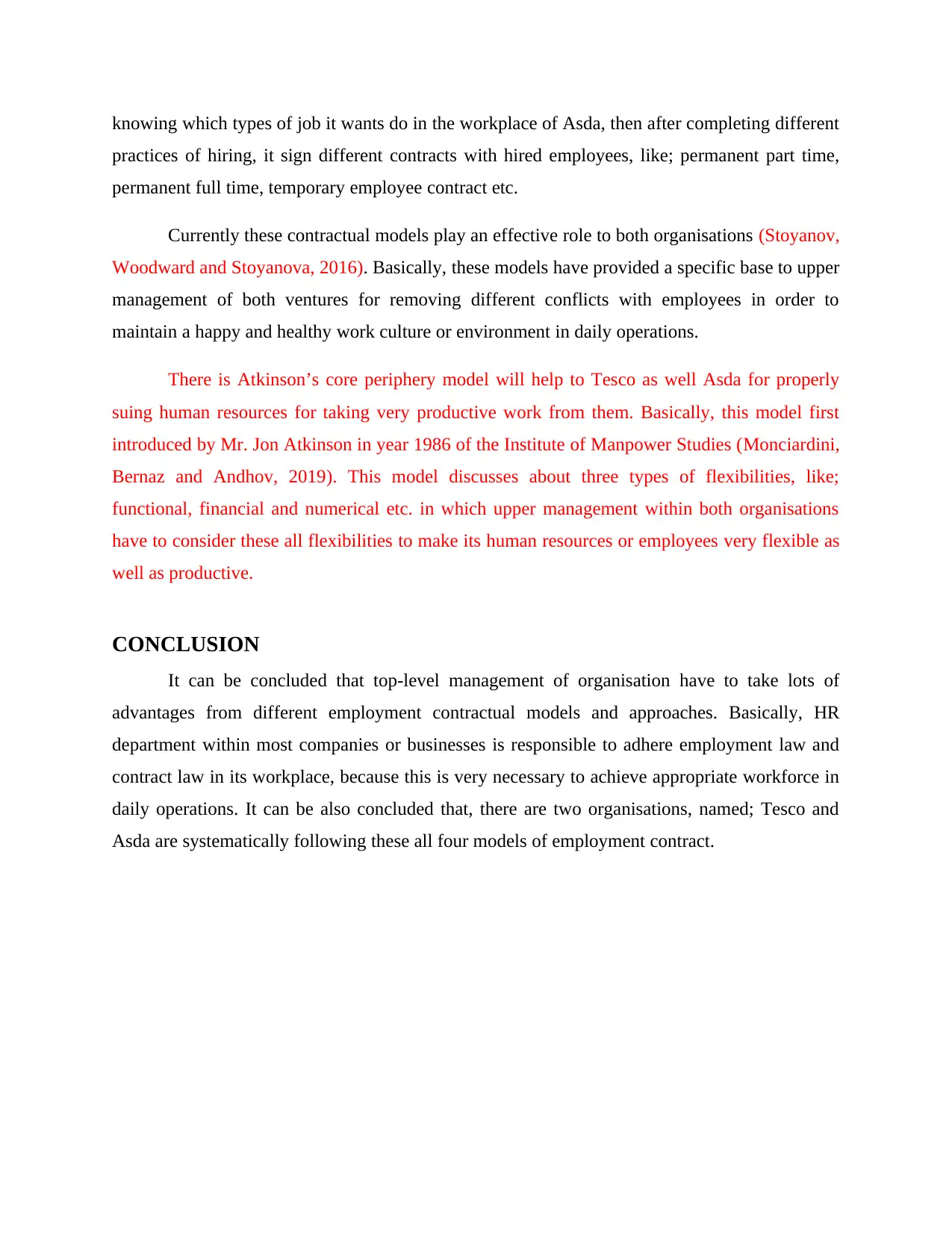
knowing which types of job it wants do in the workplace of Asda, then after completing different
practices of hiring, it sign different contracts with hired employees, like; permanent part time,
permanent full time, temporary employee contract etc.
Currently these contractual models play an effective role to both organisations (Stoyanov,
Woodward and Stoyanova, 2016). Basically, these models have provided a specific base to upper
management of both ventures for removing different conflicts with employees in order to
maintain a happy and healthy work culture or environment in daily operations.
There is Atkinson’s core periphery model will help to Tesco as well Asda for properly
suing human resources for taking very productive work from them. Basically, this model first
introduced by Mr. Jon Atkinson in year 1986 of the Institute of Manpower Studies (Monciardini,
Bernaz and Andhov, 2019). This model discusses about three types of flexibilities, like;
functional, financial and numerical etc. in which upper management within both organisations
have to consider these all flexibilities to make its human resources or employees very flexible as
well as productive.
CONCLUSION
It can be concluded that top-level management of organisation have to take lots of
advantages from different employment contractual models and approaches. Basically, HR
department within most companies or businesses is responsible to adhere employment law and
contract law in its workplace, because this is very necessary to achieve appropriate workforce in
daily operations. It can be also concluded that, there are two organisations, named; Tesco and
Asda are systematically following these all four models of employment contract.
practices of hiring, it sign different contracts with hired employees, like; permanent part time,
permanent full time, temporary employee contract etc.
Currently these contractual models play an effective role to both organisations (Stoyanov,
Woodward and Stoyanova, 2016). Basically, these models have provided a specific base to upper
management of both ventures for removing different conflicts with employees in order to
maintain a happy and healthy work culture or environment in daily operations.
There is Atkinson’s core periphery model will help to Tesco as well Asda for properly
suing human resources for taking very productive work from them. Basically, this model first
introduced by Mr. Jon Atkinson in year 1986 of the Institute of Manpower Studies (Monciardini,
Bernaz and Andhov, 2019). This model discusses about three types of flexibilities, like;
functional, financial and numerical etc. in which upper management within both organisations
have to consider these all flexibilities to make its human resources or employees very flexible as
well as productive.
CONCLUSION
It can be concluded that top-level management of organisation have to take lots of
advantages from different employment contractual models and approaches. Basically, HR
department within most companies or businesses is responsible to adhere employment law and
contract law in its workplace, because this is very necessary to achieve appropriate workforce in
daily operations. It can be also concluded that, there are two organisations, named; Tesco and
Asda are systematically following these all four models of employment contract.
Paraphrase This Document
Need a fresh take? Get an instant paraphrase of this document with our AI Paraphraser
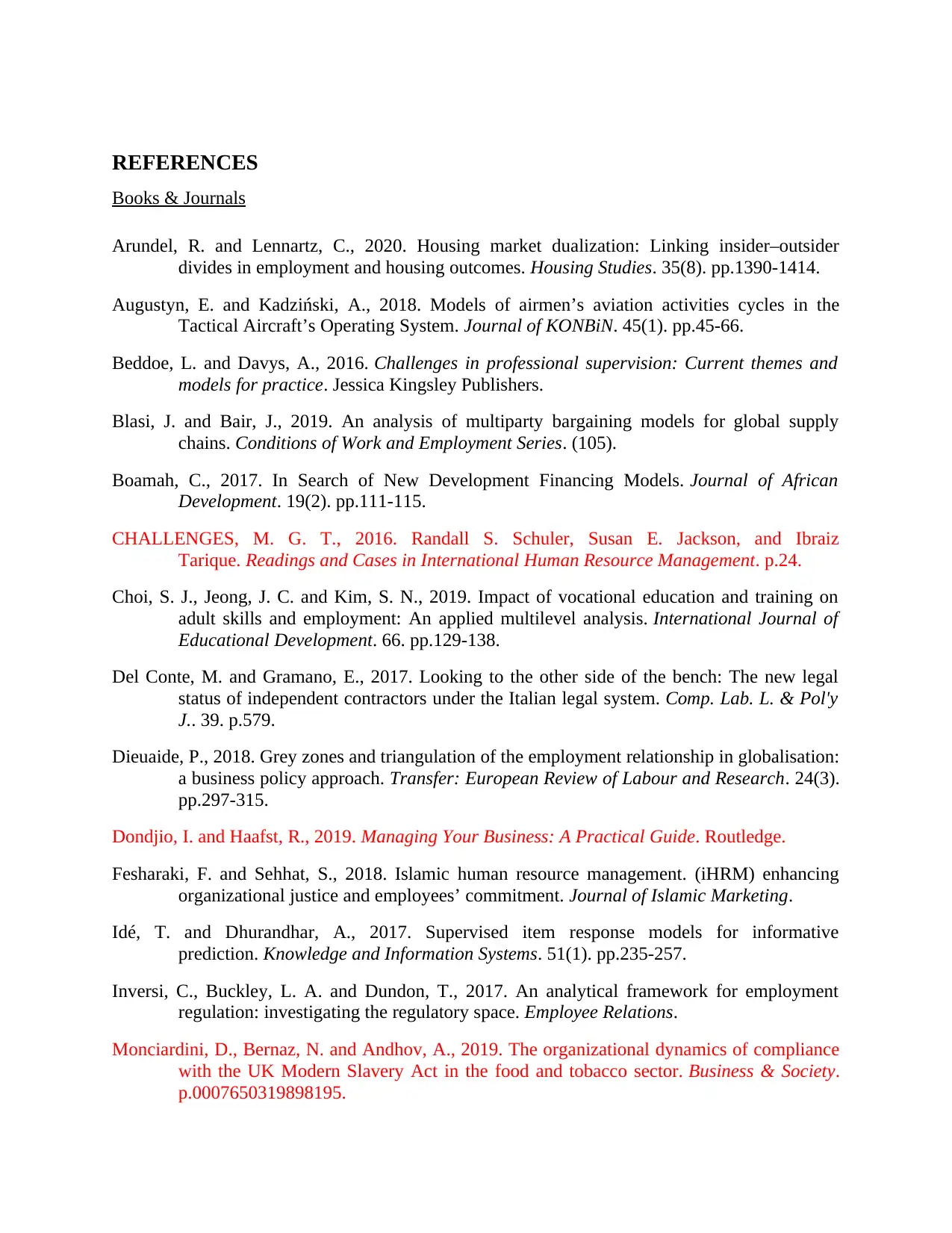
REFERENCES
Books & Journals
Arundel, R. and Lennartz, C., 2020. Housing market dualization: Linking insider–outsider
divides in employment and housing outcomes. Housing Studies. 35(8). pp.1390-1414.
Augustyn, E. and Kadziński, A., 2018. Models of airmen’s aviation activities cycles in the
Tactical Aircraft’s Operating System. Journal of KONBiN. 45(1). pp.45-66.
Beddoe, L. and Davys, A., 2016. Challenges in professional supervision: Current themes and
models for practice. Jessica Kingsley Publishers.
Blasi, J. and Bair, J., 2019. An analysis of multiparty bargaining models for global supply
chains. Conditions of Work and Employment Series. (105).
Boamah, C., 2017. In Search of New Development Financing Models. Journal of African
Development. 19(2). pp.111-115.
CHALLENGES, M. G. T., 2016. Randall S. Schuler, Susan E. Jackson, and Ibraiz
Tarique. Readings and Cases in International Human Resource Management. p.24.
Choi, S. J., Jeong, J. C. and Kim, S. N., 2019. Impact of vocational education and training on
adult skills and employment: An applied multilevel analysis. International Journal of
Educational Development. 66. pp.129-138.
Del Conte, M. and Gramano, E., 2017. Looking to the other side of the bench: The new legal
status of independent contractors under the Italian legal system. Comp. Lab. L. & Pol'y
J.. 39. p.579.
Dieuaide, P., 2018. Grey zones and triangulation of the employment relationship in globalisation:
a business policy approach. Transfer: European Review of Labour and Research. 24(3).
pp.297-315.
Dondjio, I. and Haafst, R., 2019. Managing Your Business: A Practical Guide. Routledge.
Fesharaki, F. and Sehhat, S., 2018. Islamic human resource management. (iHRM) enhancing
organizational justice and employees’ commitment. Journal of Islamic Marketing.
Idé, T. and Dhurandhar, A., 2017. Supervised item response models for informative
prediction. Knowledge and Information Systems. 51(1). pp.235-257.
Inversi, C., Buckley, L. A. and Dundon, T., 2017. An analytical framework for employment
regulation: investigating the regulatory space. Employee Relations.
Monciardini, D., Bernaz, N. and Andhov, A., 2019. The organizational dynamics of compliance
with the UK Modern Slavery Act in the food and tobacco sector. Business & Society.
p.0007650319898195.
Books & Journals
Arundel, R. and Lennartz, C., 2020. Housing market dualization: Linking insider–outsider
divides in employment and housing outcomes. Housing Studies. 35(8). pp.1390-1414.
Augustyn, E. and Kadziński, A., 2018. Models of airmen’s aviation activities cycles in the
Tactical Aircraft’s Operating System. Journal of KONBiN. 45(1). pp.45-66.
Beddoe, L. and Davys, A., 2016. Challenges in professional supervision: Current themes and
models for practice. Jessica Kingsley Publishers.
Blasi, J. and Bair, J., 2019. An analysis of multiparty bargaining models for global supply
chains. Conditions of Work and Employment Series. (105).
Boamah, C., 2017. In Search of New Development Financing Models. Journal of African
Development. 19(2). pp.111-115.
CHALLENGES, M. G. T., 2016. Randall S. Schuler, Susan E. Jackson, and Ibraiz
Tarique. Readings and Cases in International Human Resource Management. p.24.
Choi, S. J., Jeong, J. C. and Kim, S. N., 2019. Impact of vocational education and training on
adult skills and employment: An applied multilevel analysis. International Journal of
Educational Development. 66. pp.129-138.
Del Conte, M. and Gramano, E., 2017. Looking to the other side of the bench: The new legal
status of independent contractors under the Italian legal system. Comp. Lab. L. & Pol'y
J.. 39. p.579.
Dieuaide, P., 2018. Grey zones and triangulation of the employment relationship in globalisation:
a business policy approach. Transfer: European Review of Labour and Research. 24(3).
pp.297-315.
Dondjio, I. and Haafst, R., 2019. Managing Your Business: A Practical Guide. Routledge.
Fesharaki, F. and Sehhat, S., 2018. Islamic human resource management. (iHRM) enhancing
organizational justice and employees’ commitment. Journal of Islamic Marketing.
Idé, T. and Dhurandhar, A., 2017. Supervised item response models for informative
prediction. Knowledge and Information Systems. 51(1). pp.235-257.
Inversi, C., Buckley, L. A. and Dundon, T., 2017. An analytical framework for employment
regulation: investigating the regulatory space. Employee Relations.
Monciardini, D., Bernaz, N. and Andhov, A., 2019. The organizational dynamics of compliance
with the UK Modern Slavery Act in the food and tobacco sector. Business & Society.
p.0007650319898195.
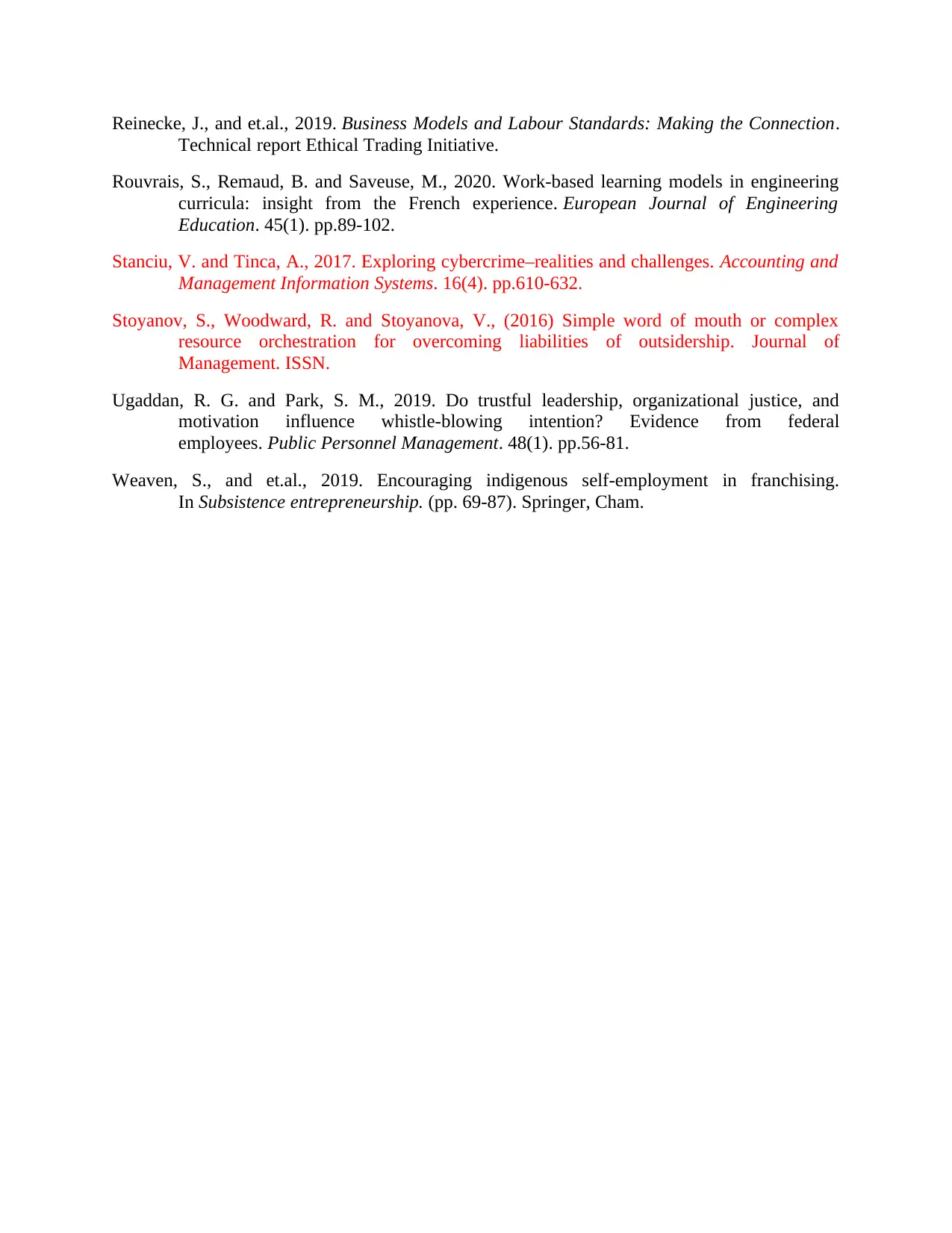
Reinecke, J., and et.al., 2019. Business Models and Labour Standards: Making the Connection.
Technical report Ethical Trading Initiative.
Rouvrais, S., Remaud, B. and Saveuse, M., 2020. Work-based learning models in engineering
curricula: insight from the French experience. European Journal of Engineering
Education. 45(1). pp.89-102.
Stanciu, V. and Tinca, A., 2017. Exploring cybercrime–realities and challenges. Accounting and
Management Information Systems. 16(4). pp.610-632.
Stoyanov, S., Woodward, R. and Stoyanova, V., (2016) Simple word of mouth or complex
resource orchestration for overcoming liabilities of outsidership. Journal of
Management. ISSN.
Ugaddan, R. G. and Park, S. M., 2019. Do trustful leadership, organizational justice, and
motivation influence whistle-blowing intention? Evidence from federal
employees. Public Personnel Management. 48(1). pp.56-81.
Weaven, S., and et.al., 2019. Encouraging indigenous self-employment in franchising.
In Subsistence entrepreneurship. (pp. 69-87). Springer, Cham.
Technical report Ethical Trading Initiative.
Rouvrais, S., Remaud, B. and Saveuse, M., 2020. Work-based learning models in engineering
curricula: insight from the French experience. European Journal of Engineering
Education. 45(1). pp.89-102.
Stanciu, V. and Tinca, A., 2017. Exploring cybercrime–realities and challenges. Accounting and
Management Information Systems. 16(4). pp.610-632.
Stoyanov, S., Woodward, R. and Stoyanova, V., (2016) Simple word of mouth or complex
resource orchestration for overcoming liabilities of outsidership. Journal of
Management. ISSN.
Ugaddan, R. G. and Park, S. M., 2019. Do trustful leadership, organizational justice, and
motivation influence whistle-blowing intention? Evidence from federal
employees. Public Personnel Management. 48(1). pp.56-81.
Weaven, S., and et.al., 2019. Encouraging indigenous self-employment in franchising.
In Subsistence entrepreneurship. (pp. 69-87). Springer, Cham.
⊘ This is a preview!⊘
Do you want full access?
Subscribe today to unlock all pages.

Trusted by 1+ million students worldwide
1 out of 12
Related Documents
Your All-in-One AI-Powered Toolkit for Academic Success.
+13062052269
info@desklib.com
Available 24*7 on WhatsApp / Email
![[object Object]](/_next/static/media/star-bottom.7253800d.svg)
Unlock your academic potential
Copyright © 2020–2025 A2Z Services. All Rights Reserved. Developed and managed by ZUCOL.





